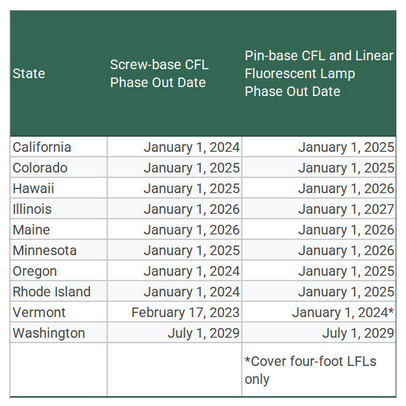By Janet B. Stroud — December 4, 2024 — If it wasn’t already on your radar, fluorescent lamp bans are already in place or are soon to be in place in many states, with the intent of replacing existing fluorescent lights with light-emitting diode (LED) bulbs in order to increase energy efficiency, reduce environmental impact, lower costs and prevent exposure to toxic mercury. Are your facilities prepared to stay compliant?
According to the Appliance Standards Awareness Project’s (ASAP) Clean Lighting site, “In 2022, Vermont and California became the first states to phase out the sale of most fluorescent bulbs. In 2023, Hawaii, Oregon, Colorado, Maine, and Rhode Island adopted similar policies. In 2024, Washington, Minnesota, and Illinois became the eighth, ninth, and tenth states to adopt clean lighting legislation.”
Of note, January 1, 2025, is the phase-out date for pin-base CFL and linear fluorescent lamps in California, Colorado, Oregon and Rhode Island, and is also the phase-out date for screw-base CFL lamps in Colorado, Hawaii and Minnesota (see ASAP chart below).
As Sean Cash of emergency lighting provider Bodine related to FMLink:
Anecdotally, we are hearing it’s a pain point for facilities as they are forced to move to LED. From the emergency lighting perspective, facilities that were running old fluorescent emergency ballasts are now forced to find something new. This isn’t always easy, especially if the person involved isn’t up to date on TLED lamp technologies AND emergency ballasts / EM inverters / EM LED drivers.
Fluorescent lighting regulation and transition resources
FMLink editors have compiled a few resources below to help you determine the regulations in the state or states in which your organization operates, navigate the switch to LED lighting, and obtain any available rebates and incentives before they expire.
“Farewell to Fluorescent Lighting: How a Phaseout Can Cut Mercury Pollution, Protect the Climate, and Save Money,” a research report from the American Council for an Energy-Efficient Economy (ACEEE) and the Appliance Standards Awareness Project (ASAP) (March 2022), advocates for government policies that intend to limit mercury to no longer exempt fluorescent lighting, explaining that drop-in mercury-free LED replacements for linear and compact fluorescent bulbs (CFLs) are now widely available and provide the same or better lighting, longer product life and much lower total cost than fluorescents.
“Clean Lighting: Shining a Light on Clean Lighting Standards” from the Appliance Standards Awareness Project (ASAP) explains the benefits of replacing fluorescent lamps with LED bulbs and offers a Clean Lighting Advocacy Toolkit for those working on regulations at the state level, including Information Resources, Advocacy Example Material, and Bill Status 2022 and 2023. It also provides the summary chart below of effective regulation dates by states. ASAP’s “General Service Fluorescent Lamps” page explains this type of lighting and pertinent standards. The site also succinctly covers National and State efficiency standards for appliances and equipment.
“New Light Bulb Standards Will Lower Costs, Cut Climate Pollution” from ASAP explains how light bulb efficiency standards (nearly all aimed at LEDs now) finalized in April 2024 by the U.S. Department of Energy (DOE) will lower energy costs for households and businesses once they take effect in 2028. ASAP notes that federal standards still permit fluorescent lighting for some bulb types, including the four-foot tubes often seen in garages and offices.
“Understand U.S. Laws that Ban Fluorescent Bulbs to Build a Greener Future” from Earth Savers Energy Services offers a state-by-state overview linked to more information on each state, designed to help you get ahead of the legislative changes by understanding how the laws affect your business or organization depending on the state (or states) in which you operate.
“A State by State Look at Light Bulb Bans [Interactive Map]” from Regency Supply (October 2024) offers a thorough overview of general service lamps, compact fluorescent lamps and linear fluorescent tubes along with current regulations, a great State-level Restriction Summary chart, and an interactive U.S. map linking to each state’s regulations and lighting products suitable for that state.
“CA to End the Sale of Fluorescent Lighting Jan 1, 2025” from AIR CRE (October 3, 2024) provides an in-depth look at California’s CA AB 2208. After January 1, 2025, California will have effectively banned the final sale and distribution of all fluorescent lamps. Aside from specialty lamps primarily used for medical or industrial purposes, the ban applies to screw, bayonet, and pin base compact fluorescent lamps (CFLs) and linear fluorescent lamps (LFLs), commonly used in both commercial and residential buildings. AIR CRE explores what this means for business owners and property managers.
“Illinois Bill to Swap Fluorescent Lamps for LED Lights Awaits Governor’s Approval” from Facilities Dive gives an in-depth look at the Clean Lighting Act in Illinois that will prohibit screw-base or bayonet-base compact fluorescent lamps from being sold or distributed as new manufactured products on or after January 1, 2026. The bill also bans the sale and distribution of pin-base compact fluorescent lamps or linear fluorescent lamps as new products on or after January 1, 2027.
“Shifting Sands: 10 States Outlaw Fluorescent Lamp Sales” from Electrical Contractor magazine (August 2024) offers a short summary of the issue and the state regulations, and discusses what electrical contractors should know to stay in compliance and direct their customers.
“Fluorescent Lighting Bans: What Commercial Property Owners Need to Know” from FSG (November 2024) provides information specific to property owners, with reasons to upgrade to LED lighting now, and “Fluorescent Light Bulb Bans in California, Colorado, and Washington: What Businesses Need to Know” (November 2024) provides a state-by-state overview and offers services to help businesses remain compliant while enhancing energy efficiency and reducing environmental impact.
“The Strategic Roadmap of the Global Lighting Industry” from the Global Lighting Association shares knowledge on global lighting trends.
Retrofits and rebates
“Will the 2025 Fluorescent Tube Ban Effect Lighting Rebates?” from Incentive Rebate360 explains the bans in relationship to incentives, rebates and bonus programs that are currently available to incentivize businesses to switch from fluorescent to LED lighting, usually providing financial assistance to cover the upfront costs of upgrading. The company notes that the states with bans may modify or discontinue rebates, so businesses might face a narrower window of opportunity to capitalize on these rebates. Incentive Rebate360 recommends that businesses should prioritize completing their lighting upgrades before the bans take effect; their experts can help companies navigate regulatory changes more smoothly and take full advantage of the available incentives.
There are numerous LED manufacturers that sell lighting products suitable to meet the upcoming regulations.

Bodine’s BLK1000 and BLK1000FL EM emergency lighting retrofit kits have proven popular to date, particularly in California. Source: Bodine
For facilities managers (FMs) who need to replace emergency lighting, Sean Cash of Bodine points out that there are three different types of TLED lamps (Type A, B, and C), and the type of emergency lighting product you need for each varies. The company offers solutions to replace each type of lamp, and Cash noted that BLK1000 and BLK1000FL EM (the latter featuring the FirstLink connected system) emergency lighting retrofit kits have proven particularly popular in California.





